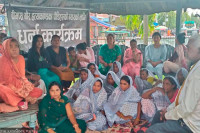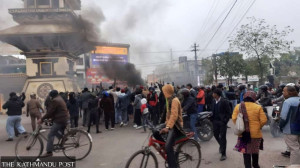National
Chief justice forwards all writs against House dissolution to the Constitutional Bench
The bench, which is led by chief justice and has four other justices as members, will start a hearing on a total of 13 petitions on Friday.
Binod Ghimire
The Supreme Court on Wednesday refused to issue an interim order on writs–a total of 12–filed by different petitioners challenging the KP Sharma Oli government’s move of dissolving the House of Representatives, and decided to forward them to the Constitutional Bench.
Lawyers arguing on behalf of the petitions challenging the Oli government’s Sunday move of dissolving the House and the President’s approval for it had demanded that Chief Justice Cholendra Shumsher Rana issue an interim order.
Chief Justice Rana had put all the 12 writs under his single bench on Wednesday.
Kishor Poudel, a media expert at the Supreme Court, said that the chief justice’s bench, after Wednesday’s hearing, decided to forward all 12 writs to the Constitutional Bench.
“The chief justice will constitute the bench incorporating four other Supreme Court justices from the roster of 14 senior justices,” Poudel told the Post. “The bench will now start hearing on the 13 writs related to the House dissolution.”
One petition, filed by advocate Santosh Bhandari, was directly sent to the Constitutional Bench on Monday after it was registered at the Supreme Court.
Lawyers on Wednesday argued that the Articles [76 (1) and (7) and 85] cited by the Office of the President to dissolve the House do not provide any ground for the dissolution. They said that Oli had breached the constitution and President Bhandari seconded him by authenticating the unconstitutional move. They argued that the responsibility now has come on the shoulders of the court to protect the constitution.
Advocate Kanchan Krishna Neupane, one of the petitioners, said the Supreme Court needs to address the constitutional crisis invited by the prime minister and the President.
“The provisions the President has cited don't allow the prime minister to dissolve the House of Representatives. The constitution doesn’t have provisions to dissolve the House when there is a scope for the formation of another government,” Neupane argued. “We have a precedent from 1995 when the Supreme Court revoked the Manmohan Adhikari government’s decision to dissolve the lower house on the same ground.”
The decision of Adhikari’s minority government to dissolve the House was rejected by the court, saying that the prime minister could not take a decision on House dissolution as long as there was the scope for forming a government.
Shambhu Thapa, another senior advocate who put forth his arguments on Wednesday, said that the House dissolution decision is not valid as per the constitution.
“The government has failed to establish the reason for announcing new elections,” said Thapa. “You [Rana] have taken an oath based on this constitution, so it is now up to you to safeguard it.”
All the lawyers taking part in Wednesday’s hearing argued that the House can be dissolved only when there is a hung assembly and there is no scope for the parties to prove a majority.
During the hearing, Rana had asked why the petitions did not provide a copy of the government’s decision to dissolve the House.
The Cabinet decision to recommend that the President dissolve the House was never made public and it was only after the Office of the President issued the notice of House dissolution did the public come to know which constitutional provisions had been cited.
In response to Chief Justice Rana’s query, lawyers said that the government decision to recommend the House dissolution was not available in the public domain.
Refusing to issue an interim order as demanded by the lawyers, Rana said that the only Article that allows the dissolution of the House is 76 (7) and that the Constitutional Bench needs to take a decision.
“Now it is necessary to ascertain on which condition the Article comes into effect,” he said. “It’s the job of the Constitutional Bench.”
Article 76 (7) states, “In cases where the prime minister appointed under clause (5) fails to obtain a vote of confidence or the prime minister cannot be appointed, the President shall, on the recommendation of the prime minister, dissolve the House of Representatives and appoint a date of election so that the election to another House of Representatives is completed within six months.”
Clause 5 relates to a member of the House of Representatives claiming that he or she can get the required majority vote.
Though Rana stopped short of elaborating, many lawyers say he might be alluding to the fact that the Oli government and the Office of the President wrongly cited Article 85.
Article 85 (1) states that unless dissolved earlier pursuant to this constitution, the term of the House of Representatives shall be five years. The current House was elected in February, 2018 under the new constitution promulgated in September 2015. Since the House has not been dissolved, its term, pursuant to Article 85, must be of five years.
The Constitutional Bench sits twice every week—on Wednesday and Friday. Given the number of writs—a total of 13—and a litany of lawyers arguing on behalf of both the plaintiffs and defendants, a decision is unlikely any time soon.
The Office of the Prime Minister and the Council of Ministers and the Office of the President have been made defendants in almost all the petitions.
After finding himself cornered in his Nepal Communist Party, Oli, in a sudden move, on Sunday morning recommended that the President dissolve the lower house of Parliament, inviting widespread opprobrium.
President Bidya Devi Bhandari later in the afternoon endorsed the recommendation. The Office of the President also declared snap polls for April 30 and May 10.
Oli’s House dissolution has led to a split in the Nepal Communist Party. The faction led by Pushpa Kamal Dahal has elected Madhav Kumar Nepal as the other chair and is claiming “their” Nepal Communist Party as the legitimate one. They have termed Oli’s House dissolution an unconstitutional move and have been demanding its reinstatement. Dev Gurung, one of the leaders from the Dahal-Nepal group, also has filed a petition at the Supreme Court challenging the Oli government’s move.
Advocates and experts on constitutional affairs have said Oli took an unconstitutional move, as the constitutional provisions do not allow a majority prime minister to dissolve the House.
Experts on constitutional affairs say now the country has to wait how the Constitutional Bench interprets the constitutional provisions.
“The issue warrants an explanation so it was bound to land in the Constitutional Bench,” said Mohan Lal Acharya, who worked as a legal adviser to the Constituent Assembly. “But since there is no constitutional complexity to ascertain that a majority government cannot dissolve the House, we can expect a decision overturning the Oli government’s move.”
Senior advocate Chandra Kant Gyawali, who specialises on constitutional law, also said that since all the writs demand an interpretation of the constitution, the Constitutional Bench has to hear them.
“Yes, these writs fall under the jurisdiction of the Constitutional Bench,” said Gyawali. “Now it is up to the bench to make a decision. An interim order wasn’t expected from Rana’s regular bench today. It’s the Constitutional Bench which should be making decisions on such matters.”




 6.3200000000001°C Kathmandu
6.3200000000001°C Kathmandu








%20(1).jpg&w=300&height=200)






